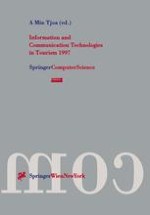For the fourth time now, experts in tourism from various countries come to attend the ENTER conference in order to inform themselves and others about the current devel opments in the usage of information and communication technologies. The ENTER conference is thought as a platform for the exchange of ideas, experi ences, opinions, and visions among scientists and practitioners. The visions presented at the last three ENTER conferences have triggered many requirements of important on-going and planned projects in the application of communication and information technologies in tourism. The scope of the papers of this proceedings covers the most recent and relevant to pics in our area of interest. The sessions are primarily devoted to intelligent agents and systems, the future role of global (reservation) systems, the new. chances of data base applications due to the most recent technological developments. and above all the role of the Internet (and Intranet). I would like to express my cordial thanks to all institutions actively supporting this event, namely: • The Edinburgh & Lothian Tourist Board • The International Federation of Information Technology in Tourism (IFITT) Several people spent numerous hours organizing the scientific programme of EN TER. The names of most of them will appear in the following pages.
